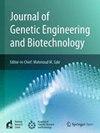四棱草生物分子抗炎作用的硅片研究
IF 2.8
Q3 Biochemistry, Genetics and Molecular Biology
Journal of Genetic Engineering and Biotechnology
Pub Date : 2025-09-09
DOI:10.1016/j.jgeb.2025.100571
引用次数: 0
摘要
目的ecd 163蛋白是一种巨噬细胞特异性蛋白和血红蛋白清道夫受体。巨噬细胞中cd163蛋白的表达升高是表明组织遭受炎症的重要特征。它可以作为牙龈炎和牙周炎等炎症性疾病的有效诊断生物标志物。四角棘草是一种有效的替代药物,用于控制炎症和治愈骨折。通过增加成骨细胞矿化,具有较高的成骨潜能。作为一种具有广泛益处的天然产物,其高抗炎和抗骨质疏松的特性可以导致药物开发。研究表明,四角草具有显著的抗炎潜能,可作为治疗药物的潜在靶点。本研究的目的是通过硅片法研究四角蛇植物营养素与cd163蛋白的相互作用,以确定其抗炎活性。材料与方法利用4.0 PyRx软件Autodock对从四角草植物中提取的β-谷甾醇、木犀草素、皮杉醇、四角草素、白藜芦醇、单宁等生物分子进行分子对接。结果研究结果表明,具有生物活性的四角蛇分子具有抗cd163蛋白相关炎症的药物相似性和结合亲和力。结论四棱草生物分子具有抗炎活性,可通过体外分析进一步开发新药。本文章由计算机程序翻译,如有差异,请以英文原文为准。
In-silico study on biomolecules derived from Cissus quadrangularis towards anti-inflammation
Objective
CD 163 protein is a macrophage-specific protein and hemoglobin scavenger receptor. Elevated expression of CD 163 protein in macrophages is an important feature indicating that tissues are subjected to inflammation. It can be an effective diagnostic biomarker for inflammatory diseases like gingivitis and periodontitis. Cissus quadrangularis is used as a potent alternative medicine to control inflammation and heal fractured bones. It has high osteogenic potential by increasing osteoblast mineralization. Being a natural product with a wide range of benefits can lead to drug development for its high anti-inflammatory and anti-osteoporotic properties. Studies have shown that Cissus quadrangularis has significant anti-inflammatory potential and can be used as a potential target for therapeutic agents. The objective of the study is to explore the interaction of the phytonutrients derived from Cissus quadrangularis with CD 163 protein to establish the anti-inflammatory activity by in silico approach.
Materials and methods
The biomolecules derived from the plant Cissus quadrangularis namely β-Sitosterol, luteolin, piceatannol, quadrangualrin, resveratrol, and tannins were subjected to molecular docking using Autodock of 4.0 PyRx software.
Results
The study results showed drug-likeness and binding affinity between biologically active Cissus quadrangularis molecules against inflammation associated with CD 163 protein.
Conclusion
It can be concluded that the biomolecules derived from Cissus quadrangularis exhibited anti-inflammatory potential and thus it can be further explored by invitro analysis in developing a new drug.
求助全文
通过发布文献求助,成功后即可免费获取论文全文。
去求助
来源期刊

Journal of Genetic Engineering and Biotechnology
Biochemistry, Genetics and Molecular Biology-Biotechnology
CiteScore
5.70
自引率
5.70%
发文量
159
审稿时长
16 weeks
期刊介绍:
Journal of genetic engineering and biotechnology is devoted to rapid publication of full-length research papers that leads to significant contribution in advancing knowledge in genetic engineering and biotechnology and provide novel perspectives in this research area. JGEB includes all major themes related to genetic engineering and recombinant DNA. The area of interest of JGEB includes but not restricted to: •Plant genetics •Animal genetics •Bacterial enzymes •Agricultural Biotechnology, •Biochemistry, •Biophysics, •Bioinformatics, •Environmental Biotechnology, •Industrial Biotechnology, •Microbial biotechnology, •Medical Biotechnology, •Bioenergy, Biosafety, •Biosecurity, •Bioethics, •GMOS, •Genomic, •Proteomic JGEB accepts
 求助内容:
求助内容: 应助结果提醒方式:
应助结果提醒方式:


